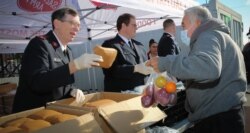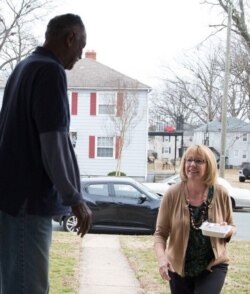Salvation Army food trucks are parked in low-income neighborhoods in Chicago, Atlanta and Los Angeles not to sell food but to bring free meals to residents during the COVID-19 pandemic.
“Most people we serve live in poverty or from paycheck to paycheck,” said Dale Bannon, the Salvation Army’s national community relations director. “Many of them were the first to be cut from their jobs and are unemployed right now, so we have to find creative solutions to get food to people who desperately need it.”
Charitable organizations like the Salvation Army USA have been at the forefront of the crisis in the United States, where the need for community feeding programs has doubled in many areas around the country.
“We’re also helping people in homeless shelters and supplying food pantries with fresh fruit and vegetables,” Bannon said, along with boxes of canned goods “that would sustain a family of four for a week.”
The demand for food is also increasing for seniors, said Ellie Hollander, president of Meals on Wheels America. Hollander said they are “still making sure that meals are getting to seniors who need them,” a population that is also more vulnerable to becoming severely ill with the coronavirus.
Meals on Wheels volunteers usually deliver daily hot meals to adults over the age of 60 who are homebound, many of whom have disabilities. But with social distancing, frozen foods or packages with canned food may be dropped off less frequently at the door instead of handed to the client.
At senior centers, where the organization was providing group meals for mobile adults before the epidemic, “we now have pickup grab-and-go containers or a drive-thru, where food is distributed through a vehicle window,” Hollander explained.
The No Kid Hungry campaign provides funding to schools and community organizations to help children who do not get enough food. This includes free or reduced-price meals for low-income youths in schools.
With schools closing early this year because of COVID-19, “22 million kids that relied on getting breakfast and lunch at school now have a gap we need to fill,” said Lisa Davis, senior vice president of the No Kid Hungry campaign.
She said food is currently being dropped off at school bus stops, or “families are coming to the school cafeteria to pick up five days of meals at a time.”
Save the Children is partnering with No Kid Hungry through their Save the Stories program that uses school buses “to drop off learning materials to kids, as well as meals,” said group president Janti Soeripto.
The group serves rural areas, where bags of books are also dropped off at children homes. Soeripto notes that since at least half the communities do not have access to the internet, books, games and other educational materials are important resources for the underserved population.
Concerned that funding for relief programs will decrease but demands for help will not, humanitarian groups are reaching out to the U.S. Congress to provide millions of dollars in emergency funding.
“People who didn’t need our services before now need it,” Bannon, of the Salvation Army, said. “And we anticipate the need is going to be even greater in the coming months” as the epidemic continues to spread across the United States.










